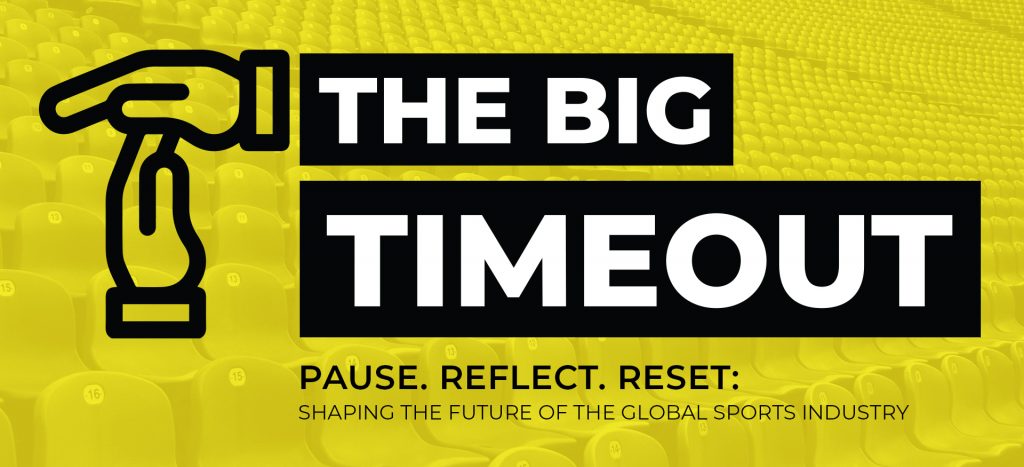
For over 60 years the sports industry has experienced almost uninterrupted growth. Since Mark McCormack signed his first deal with Arnold Palmer in the 1960s, sport has been virtually recession-proof, as a constant flow of new revenue streams fuelled an ever-expanding industry.
It has taken a global pandemic to put a pause on the industry. Some would argue that there were cracks emerging pre COVID-19, and the enforced shut down of the global sport industry has simply sped up the widening of these cracks. But nonetheless, with sports from elite to grassroots on enforced shutdown around the world, we have an amazing opportunity to re-group as an industry. A Big Timeout. A time to Pause, Reflect and Reset.
To share some thoughts on this Big Timeout, we brought together a panel of industry leaders to bring diverse perspectives to the discussion – different sports, different roles and different sorts of organisations.
We held this discussion under our banner of “Going To Gemba” – the sixth in our series (thegembagroup.com/news/going-to-gemba-events) where we look at emerging issues and opportunities facing the global sport and entertainment industry. The concept is inspired by the Japanese origins of our name – to “go to the gemba” is to step away from your day to day routine, to talk to people at the coal face, to ask questions and to learn.
This post summarises some of the highlights of a dynamic and challenging conversation about the future of the global sports industry post COVID-19.
Commercial partnerships/sponsorships insights
Solidarity. This was a theme across all our panellists and their relationships with commercial partners through such a disruptive time.
“The biggest thing we’ve seen is coming together of stakeholders during this time of crisis, from brands, broadcasters, rightsholders,” said Ross McCall, Head of Commercial Strategy and Planning at FIFA. “It’s a collective effort to ensure we make the most of this difficult time to protect key revenues and create new ones where possible.”
Kylie Rogers, General Manager Commercial at the Australian Football League (AFL), said: “The silver lining in all of this is the way our industry has come together and collaborated.” While she did acknowledge that there are sponsors that have been opportunistic and looked to refactor deals as the AFL season was disrupted, she spoke of her strategy to focus on aligned values with partners, on “value-based” arrangements with an emphasis on working with partners that want to leave a positive legacy, and use sport as a mechanism to do that.
“We’re identifying partners that share the same values as us, articulating early on what the partnership strategy is and what their legacy will be in that space,” Rogers said. “And being very agile and flexible on how they demonstrate those values and how they tell the world about the partnership.”
She cited BHP, the new major partner of AFLW, the game’s elite women’s competition. BHP had announced that it will be gender balanced across its staff by 2025. “They share our belief that it’s the right of every girl and every woman to participate in our game in some way, shape or form. We set out very clearly what the strategic priorities of the partnership will be, what their legacy will be, and how we support each other through our gender balance goals. And how they do that will actually change each year.”
This flexibility in long-term partnerships may be an overdue positive structural change in the sports sector arising from COVID-19. Compared to traditional media businesses, where advertising is transacted on much shorter timeframes, in sport multi-year deals with prescriptive rights and benefits are still common. But these sorts of deals make it difficult to flex assets to meet the changing needs of the partner or the rights holder. Much better, as Rogers said, to align on strategic objectives but allow for flexibility in how those objectives are activated through the partnership.
Momentum in women’s sport
With the recent announcement of New Zealand and Australia as joint hosts of the 2023 FIFA Women’s World Cup, discussion around how to continue to build the momentum of girls and women in sport is a hot topic. McCall said that FIFA will commit US$1 billion into women’s football between now and 2023 across three pillars: growing participation, enhancing the commercial value, and building the foundations.
The 2023 World Cup will be the biggest yet, with 32 teams and national sides from many more nations in the running to qualify – providing the chance to build interest and grass-roots engagement in football globally. Rogers expressed her support for the event – a different code of football to the AFL’s Aussie Rules – and the view that the lead-up and the event itself will be a boon for women’s sport overall, not just for football.
Getting fans back into venues
Matt Roberts, Research and Analytics Director at Formula 1, explained how his organisation is thinking through getting fans back to the track in over 20 countries around the world. While overall F1’s research indicates that a significant proportion of fans will be ready to go back to attending live events soon, there are some for whom the risks and fears of COVID-19 will linger. As such, F1 is polling fans around the world and working through the different responses.
“We can’t use precedence as a benchmark,” he said, because no-one has been through a global pandemic before. “We will look at previous studies, look at the realities and create some dampening factors” to account for some regions where fans tend to over-estimate their likely behaviour, and other regions where they tend to under-estimate.
“But with no benchmarks to relate to with the impact of pandemics on consumer research, there are unknowns as to what the future looks like.”
Technology will play a role. F1 had previously been using beacon technology to anonymously track fan movements around the track – where they linger, how they transition around different areas – and these insights are now helping map future designs of grandstands, commercial activations, and other areas where fans congregate. “We have the ability to use phone tagging data to understand how people behave around the circuit, which will be critical in managing crowd control and ensure people feel safe at our events in a post-COVID world,” Roberts said.
Our poll results from the session indicated that our sample of sport business professionals think that building confidence amongst fans will be the biggest challenge in getting crowds back.

Best and worst things about this period
There is of course no hiding from the challenges the sports industry faces. As McCall said: “A lot of leagues, sports and clubs might not survive and there will be a reset. A lot of great people have lost their jobs. The resilience that sport prides itself on is being tested.”
For Rogers, having to stand down 80% of staff at AFL headquarters was “one of the worst days of my career”.
But all three speakers were looking ahead and already reflecting on the positives that have emerged during COVID-19. (This optimism was shared in an audience poll we conducted during the event, where 75% of people said the industry will emerge stronger by 2025 as a result of the current crises.)
Formula 1’s Roberts said: “It’s a good opportunity to take stock of where we are as a business and think strategically about where we want to be as a business.” He noted that things the sport had not previously been willing to try, such as racing in August while teams took holidays, are now happening or at least on the table for discussion. “The adaptability of our sport will be something we will look back on fondly – it will help us in the future when we have to make decisions.”
Another positive for our panellists was how this period has reinforced the importance of the fan – if we did need reminding of the centrality of fans to the sport industry, the experience of playing sport in empty stadiums has shown just how important fans are to the overall experience and enjoyment of sport. Rogers expects we will see renewed investment in fan experience and fan technology to improve that experience at venues, and keep fans coming back in numbers to create the atmosphere that athletes thrive on, and in turn improve the quality of the broadcast product as well.
The best thing coming out of this disruptive period, according to FIFA’s McCall? “The solidarity across the industry: rightsholders, brands, broadcasters and fans – everyone has worked together. The productive conversations we’ve had have reinforced commercial partnerships and symbiotic relationships between parties.
Our panellists
 |
Ross McCall, Head of Commercial Strategy & Planning @ FIFA Building on a career in the sports industry initially with Repucom, Ross has led business intelligence and commercial strategy at one of, if not the world’s most influential global sporting organisations, FIFA. |
 |
Kylie Rogers, General Manager Commercial @ Australian Football League (AFL) Kylie has led the Commercial Operations of one of Australia’s most commercially successful sporting leagues, the AFL. Kylie brings a rich understanding and insights in the intersection of sport, media and sponsorship and the commercial realities of top tier sports and entertainment in Australia. |
 |
Matt Roberts, Research and Analytics Director @ Formula 1 Matt leads fan research and customer analytics for one of the most technologically advanced sports in the world, F1. In his current role, he’s responsible for all data and insight which helps drive fan engagement and commercial revenue opportunities within the sport. |
 |
Rob Mills, Global CEO & Director @ Gemba Rob is Global CEO and Director of Gemba, a consultancy providing insights, strategy and communications to the sport and entertainment industry. Rob is currently based in London rolling out Gemba’s sponsorship valuation platform – Turnstile. |